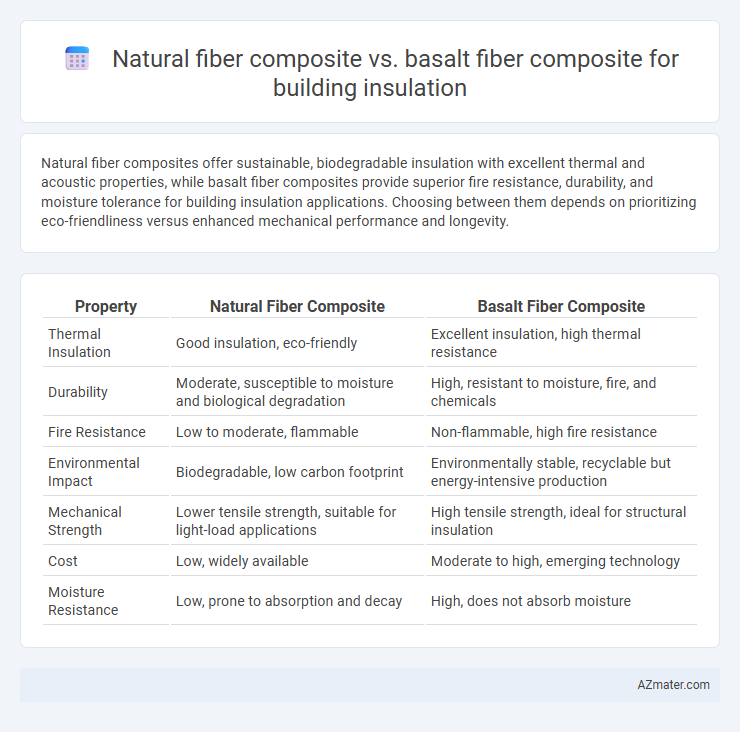Natural fiber composites offer sustainable, biodegradable insulation with excellent thermal and acoustic properties, while basalt fiber composites provide superior fire resistance, durability, and moisture tolerance for building insulation applications. Choosing between them depends on prioritizing eco-friendliness versus enhanced mechanical performance and longevity.
Table of Comparison
| Property | Natural Fiber Composite | Basalt Fiber Composite |
|---|---|---|
| Thermal Insulation | Good insulation, eco-friendly | Excellent insulation, high thermal resistance |
| Durability | Moderate, susceptible to moisture and biological degradation | High, resistant to moisture, fire, and chemicals |
| Fire Resistance | Low to moderate, flammable | Non-flammable, high fire resistance |
| Environmental Impact | Biodegradable, low carbon footprint | Environmentally stable, recyclable but energy-intensive production |
| Mechanical Strength | Lower tensile strength, suitable for light-load applications | High tensile strength, ideal for structural insulation |
| Cost | Low, widely available | Moderate to high, emerging technology |
| Moisture Resistance | Low, prone to absorption and decay | High, does not absorb moisture |
Introduction to Fiber Composites for Building Insulation
Fiber composites for building insulation combine natural or synthetic fibers with a resin matrix to enhance thermal performance and durability. Natural fiber composites, such as those using hemp, flax, or jute, offer renewable, biodegradable, and lightweight options with good thermal and acoustic insulation properties. Basalt fiber composites utilize mineral-based basalt fibers known for high thermal resistance, fire retardancy, and mechanical strength, making them suitable for advanced insulation applications where durability and heat exposure are critical.
Overview of Natural Fiber Composites
Natural fiber composites for building insulation leverage renewable materials such as hemp, flax, jute, and kenaf, offering high thermal insulation properties and biodegradability. These composites provide moisture regulation and sound absorption benefits, contributing to sustainable building practices with reduced environmental impact compared to synthetic alternatives. Their lightweight nature and ease of processing enhance energy efficiency in insulation applications while promoting circular economy principles.
Properties of Basalt Fiber Composites
Basalt fiber composites exhibit superior thermal resistance and mechanical strength compared to natural fiber composites, making them highly effective for building insulation. These composites offer excellent fire retardancy, chemical stability, and durability under high temperatures, ensuring long-term performance in harsh environmental conditions. Their high tensile strength and resistance to moisture absorption contribute to enhanced insulation efficiency and structural integrity in construction applications.
Thermal Performance: Natural vs. Basalt Fiber Composites
Natural fiber composites offer moderate thermal insulation properties due to their low thermal conductivity and moisture-regulating capabilities, making them effective in reducing heat transfer in building envelopes. Basalt fiber composites exhibit superior thermal stability and resistance to high temperatures, maintaining structural integrity and insulation performance under extreme conditions. Comparing thermal performance, basalt fiber composites provide enhanced fire resistance and durability, whereas natural fibers excel in eco-friendly thermal regulation and sustainability.
Mechanical Strength Comparison
Natural fiber composites, such as those made from hemp or flax, typically offer lower mechanical strength compared to basalt fiber composites, which exhibit higher tensile strength and greater stiffness due to basalt's inherent mineral composition. Basalt fiber composites provide superior durability and resistance to mechanical stress, making them more suitable for structural applications requiring enhanced load-bearing capacity. The improved mechanical properties of basalt fiber composites contribute to better performance in building insulation systems where strength and long-term stability are critical.
Environmental Impact and Sustainability
Natural fiber composites, derived from renewable sources such as hemp, flax, or jute, offer low embodied energy and excellent biodegradability, making them highly sustainable for building insulation with minimal environmental impact. Basalt fiber composites, produced from volcanic rock, provide superior durability and thermal stability but involve higher energy consumption and CO2 emissions during manufacturing, impacting their overall carbon footprint. Choosing natural fiber composites supports circular building practices and reduces landfill waste, while basalt fiber composites enhance longevity and fire resistance, balancing environmental concerns with performance needs.
Moisture Resistance and Durability
Natural fiber composites, such as hemp or flax-based materials, offer moderate moisture resistance but are prone to biodegradation and fungal growth under high humidity, limiting their durability in building insulation applications. Basalt fiber composites deliver superior moisture resistance due to their inorganic, non-absorbent nature, maintaining structural integrity and thermal performance even in damp environments. The enhanced durability of basalt fiber composites makes them a preferred choice for long-term building insulation where moisture exposure is a critical concern.
Cost Analysis and Availability
Natural fiber composites, derived from materials like hemp, flax, and jute, offer cost-effective insulation solutions due to their low raw material prices and wide agricultural availability, making them economically favorable for sustainable building projects. Basalt fiber composites, sourced from volcanic rock, present higher upfront costs driven by energy-intensive production processes and limited manufacturing facilities, impacting their price competitiveness in large-scale construction markets. Availability of natural fibers is more regional and renewable, whereas basalt fibers rely on industrial infrastructure that restricts supply flexibility and increases logistical expenses in building insulation applications.
Health and Safety Considerations
Natural fiber composites for building insulation offer superior breathability and reduced skin irritation, minimizing respiratory hazards during installation compared to basalt fiber composites. Basalt fiber composites, while providing enhanced fire resistance and durability, may release fine particulates that require protective gear to prevent inhalation risks. Selecting natural fiber composites promotes healthier indoor air quality and reduced allergenic potential, making them favorable for environmentally conscious construction focused on occupant safety.
Conclusion: Choosing the Right Composite for Insulation
Natural fiber composites offer excellent thermal insulation, biodegradability, and cost-effectiveness, making them ideal for sustainable building projects. Basalt fiber composites provide superior durability, fire resistance, and mechanical strength, suitable for high-performance insulation requirements. Selecting the right composite depends on balancing environmental impact, thermal efficiency, and structural demands specific to the building application.

Infographic: Natural fiber composite vs Basalt fiber composite for Building insulation
 azmater.com
azmater.com